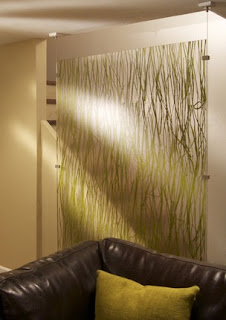When I got out of college and was in graduate school and working, I lived in a small studio apartment in Manhattan. It needed to serve as my bedroom, library, dining room and a place to entertain. It's easy update a single room - on a budget - and better to have someone handy to help. My Dad was invaluable in helping me design and build some unique dividers and dual use pieces. Here are some updated ideas for space planning and decorating that you can try.
Create a movable wall. Do you have a dresser? A headboard? A bookcase? In a single room apartment, they can serve as a room divider. Even your dining table can separate the kitchen from the bedroom; try a bench seat on one side and chairs on the other. Second-hand windows, doors and shutters, hinged together make great folding screens depending upon your style. For the do-it-yourself expert, build a divider from shelves, blocking off some of the openings for more privacy. If a wall is more your style, build one that can be removed, inserting tempered glass or plexiglass to keep light moving through. To separate my kitchenette from the rest of the space I had my dad build a tall cabinet then adding an upper cabinet and bar height table that attached to the wall. It kept the space open, gave me a table and a desk and plenty of great storage. If you own your apartment, invest in room dividers that nest into the walls when not in use or revolve storage and the TV from one side to the other.
Let the light in. Privacy is key in a big city, but small spaces NEED light. A transparent or open-weave room divider can keep your bedroom or guest sleeping area private from the public space. Leaving windows un-dressed (no drapes or hard treatments) using window film is another option. For simplicity use frosted effect films, or for drama use patterns and textures. Add light inside cabinets, shelves, under moldings, surrounding art, and under or behind large pieces of furniture: LED strips and ropes provide light without producing heat or using much energy. If you can, remove the doors in hallways to let the light shine through the space.
Uniformity is best. To make small spaces seem larger, unifying the color scheme is best. Monochromatic color schemes in neutral colors will help make walls and floors seem larger. Accent the space with colorful artwork and large scale accessories. If you have many collectibles, group them in one area to keep the space looking open.

Store it. Having a clutter-free space is attractive as well as provides peace of mind. For that dual-duty kitchen table/desk, find some great wicker or paper boxes with lids and store your papers and office supplies. Have an extra closet? Turn it into a home office so you can close the door on your work. You can update a bookcase with ready made or DIY doors so you can close off messy shelves. Don't forget under-bed storage and benches or ottomans that tuck everything from seasonal clothes to extra blankets and pillows inside. If you have the depth, turn your walls into bookshelves, storage cabinets and even a space for your TV.


